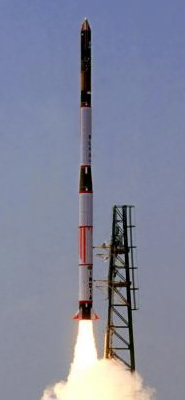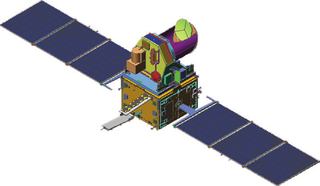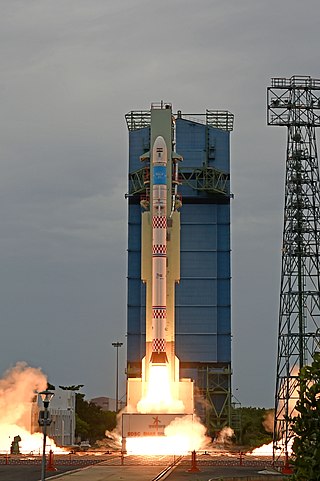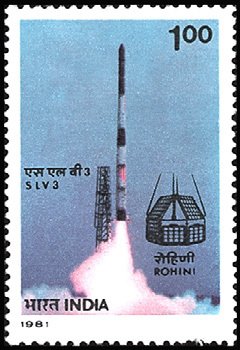| Manufacturer | ISRO |
|---|---|
| Country of origin | India |
| Operator | ISRO |
| Applications | Experimental Satellites |
| Specifications | |
| Launch mass | 30–41.5 kilograms (66–91 lb) |
| Dimensions | 360 |
| Power | 3 watts (RTP) 16 watts (others) |
| Equipment | Launch Vehicle monitor Solid State camera(RS-D2) |
| Regime | 400km Circular Low Earth |
| Design life | 8 |
| Dimensions | |
| Production | |
| Status | Retired |
| Launched | 4 |
| Retired | 2 |
| Lost | 2 |
| Maiden launch | RTP 10 August 1979 Rohini Satellite 1 18 July 1980 (Successful) |
| Last launch | Rohini RS-D2 17 April 1983 |
| Last retirement | Rohini RS-D2 |
| Related spacecraft | |
| Derived from | 6 |
| Derivatives | 5 |
Rohini is a series of satellites launched by the Indian Space Research Organisation (ISRO). The Rohini series consisted of four satellites, each of which was launched by the Satellite Launch Vehicle (SLV) [1] and three of which made it successfully to orbit. The series were mostly experimental satellites, with the first launch being in 1979. There was an earlier series of ISRO sounding rockets with the same name, first launched 1967.
It was a 35 kg (77 lb) experimental spin stabilized satellite that used 3W of power and was launched on 10 August 1979 from SDSC. [2] The satellite contained instruments to monitor the launch vehicle. The satellite could not be placed into its intended orbit.
It was also a 35 kg (77 lb) experimental spin stabilized satellite that used 16W of power and was successfully launched on 18 July 1980 from Satish Dhawan Space Centre [3] into an orbit of 305 km × 919 km (190 mi × 571 mi) with an inclination of 44.7°. It was the first satellite successfully launched by the indigenous launch vehicle SLV. This was India's first indigenous satellite launch, making it the seventh nation to possess the capability to launch its own satellites on its own rockets. [4] [5] [6] It provided data on the fourth stage of SLV. The satellite had mission life of 1.2 years and an orbital life of 20 months.
It was a 38 kg (84 lb) experimental spin stabilized satellite that used 16W of power and was launched on 31 May 1981. [7] The launch of the SLV was a partial success as the satellite did not reach the intended height and thus it only stayed in orbit for 9 days. It achieved an orbit of 186 km × 418 km (116 mi × 260 mi) with an inclination of 46°. The satellite carried a solid state camera for remote sensing applications (Landmark Tracker) and performed to specifications.
It was a 41.5 kg (91 lb) experimental spin stabilized satellite that used 16W of power and was launched successfully on 17 April 1983 [8] into an orbit of 371 km × 861 km (231 mi × 535 mi) and an inclination of 46°. The satellite was in operation (mission life) for 17 months and its main payload, a smart sensor camera, took over 2500 pictures. The camera had the capability to take pictures both in visible and infrared bands. After an orbital life of 7 years, the satellite reentered the Earth atmosphere on 19 April 1990.

The Polar Satellite Launch Vehicle (PSLV) is an expendable medium-lift launch vehicle designed and operated by the Indian Space Research Organisation (ISRO). It was developed to allow India to launch its Indian Remote Sensing (IRS) satellites into Sun-synchronous orbits, a service that was, until the advent of the PSLV in 1993, only commercially available from Russia. PSLV can also launch small size satellites into Geostationary Transfer Orbit (GTO).

The Indian National Satellite System or INSAT, is a series of multipurpose geostationary satellites launched by ISRO to satisfy telecommunications, broadcasting, meteorology, and search and rescue operations. Commissioned in 1983, INSAT is the largest domestic communication system in the Indo-Pacific Region. It is a joint venture of the Department of Space, Department of Telecommunications, India Meteorological Department, All India Radio and Doordarshan. The overall coordination and management of INSAT system rests with the Secretary-level INSAT Coordination Committee.
The Vanguard rocket was intended to be the first launch vehicle the United States would use to place a satellite into orbit. Instead, the Sputnik crisis caused by the surprise launch of Sputnik 1 led the U.S., after the failure of Vanguard TV-3, to quickly orbit the Explorer 1 satellite using a Juno I rocket, making Vanguard 1 the second successful U.S. orbital launch.

The Indian Space Research Organisation is the national space agency of India. It operates as the primary research and development arm of the Department of Space (DoS), which is directly overseen by the Prime Minister of India while the Chairman of ISRO also acts as the executive of DoS. ISRO is primarily responsible for performing tasks related to space-based operations, space exploration, international space cooperation and the development of related technologies. ISRO is one of the six government space agencies in the world that possesses full launch capabilities, can deploy cryogenic engines, can launch extraterrestrial missions and operate a large fleet of artificial satellites. ISRO is one of the four government space agencies to have soft landing (uncrewed) capabilities.
The Vikram Sarabhai Space Centre (VSSC) is a major space research centre of the Indian Space Research Organisation (ISRO), focusing on rocket and space vehicles for India's satellite programme. It is located in Trivandrum, in the Indian state of Kerala.

Aryabhata was India's first satellite, named after the astronomer. It was launched on 19 April 1975 from Kapustin Yar, a Soviet rocket launch and development site in Astrakhan Oblast using a Kosmos-3M launch vehicle. It was built by ISRO, and launched by the Soviet Union as a part of the Soviet Interkosmos programme which provided access to space for friendly states.

Satish Dhawan Space Centre – SDSC, is the primary spaceport of the Indian Space Research Organisation (ISRO), located in Sriharikota, Andhra Pradesh.

The Satellite Launch Vehicle or SLV was a small-lift launch vehicle project started in the early 1970s by the Indian Space Research Organisation to develop the technology needed to launch satellites. SLV was intended to reach a height of 400 kilometres (250 mi) and carry a payload of 40 kg (88 lb). The first experimental flight of SLV, in August 1979, was a failure. The first successful launch took place on 18 July 1980.

The Augmented Satellite Launch Vehicle or Advanced Satellite Launch Vehicle was a small-lift launch vehicle five-stage solid-fuel rocket developed by the Indian Space Research Organisation (ISRO) to place 150 kg satellites into LEO. This project was started by India during the early 1980s to develop technologies needed for a payload to be placed into a geostationary orbit. Its design was based on Satellite Launch Vehicle. ISRO did not have sufficient funds for both the Polar Satellite Launch Vehicle programme and the ASLV programme at the same time and the ASLV programme was terminated after the initial developmental flights. The payloads of ASLV were Stretched Rohini Satellites.

The Launch Vehicle Mark-3 or LVM3 is a three-stage medium-lift launch vehicle developed by the Indian Space Research Organisation (ISRO). Primarily designed to launch communication satellites into geostationary orbit, it is also due to launch crewed missions under the Indian Human Spaceflight Programme. LVM3 has a higher payload capacity than its predecessor, GSLV.

Megha-Tropiques was a satellite mission to study the water cycle in the tropical atmosphere in the context of climate change. A collaborative effort between Indian Space Research Organisation (ISRO) and French Centre National d’Etudes Spatiales (CNES), Megha-Tropiques was successfully deployed into orbit by a PSLV rocket in October 2011.

RISAT (Radar Imaging Satellite) is a series of Indian radar imaging reconnaissance satellites built by the Indian Space Research Organization (ISRO). They provide all-weather surveillance using synthetic aperture radars (SAR).

The Mars Orbiter Mission (MOM), unofficially known as Mangalyaan, was a space probe orbiting Mars since 24 September 2014. It was launched on 5 November 2013 by the Indian Space Research Organisation (ISRO). It was India's first interplanetary mission and it made ISRO the fourth space agency to achieve Mars orbit, after Roscosmos, NASA, and the European Space Agency. It made India the first Asian nation to reach the Martian orbit and the first nation in the world to do so on its maiden attempt.

GSAT-29 is a high-throughput communication satellite developed by the Indian Space Research Organisation (ISRO). The mission aims at providing high-speed bandwidth to Village Resource Centres (VRC) in rural areas. The two Ku and Ka operational payloads will provide communication services to Jammu and Kashmir and Northeast India under Digital India programme. At the time of launch GSAT-29 was the heaviest satellite, weighing 3,423 kg (7,546 lb), that was placed in orbit by an Indian launch vehicle. Approved cost of GSAT-29 is ₹175.63 crore (US$22 million).

The Small Satellite Launch Vehicle (SSLV) is a small-lift launch vehicle developed by ISRO with payload capacity to deliver 500 kg (1,100 lb) to low Earth orbit or 300 kg (660 lb) to Sun-synchronous orbit for launching small satellites, with the capability to support multiple orbital drop-offs. SSLV is made keeping low cost, low turnaround time in mind with launch-on-demand flexibility under minimal infrastructure requirements.

The PSLV-C44 was the 46th mission of the Indian Polar Satellite Launch Vehicle (PSLV) program. It was the first flight of PSLV-DL, having 2 strap-on boosters and placed a primary payload Microsat-R and a secondary payload of Kalamsat V2 in Sun-synchronous orbits.

Rohini Satellite 1 or RS-1 is the first satellite successfully launched by India using indigenously developed rockets. After the launch on 18 July 1980 by a SLV rocket, India became the 7th country to have rocket launching capability.

The PSLV C-58 was the 60th flight of the Indian Space Research Organisation's Polar Satellite launch Vehicle. It carried the XPoSAT mission along with rideshare payloads.